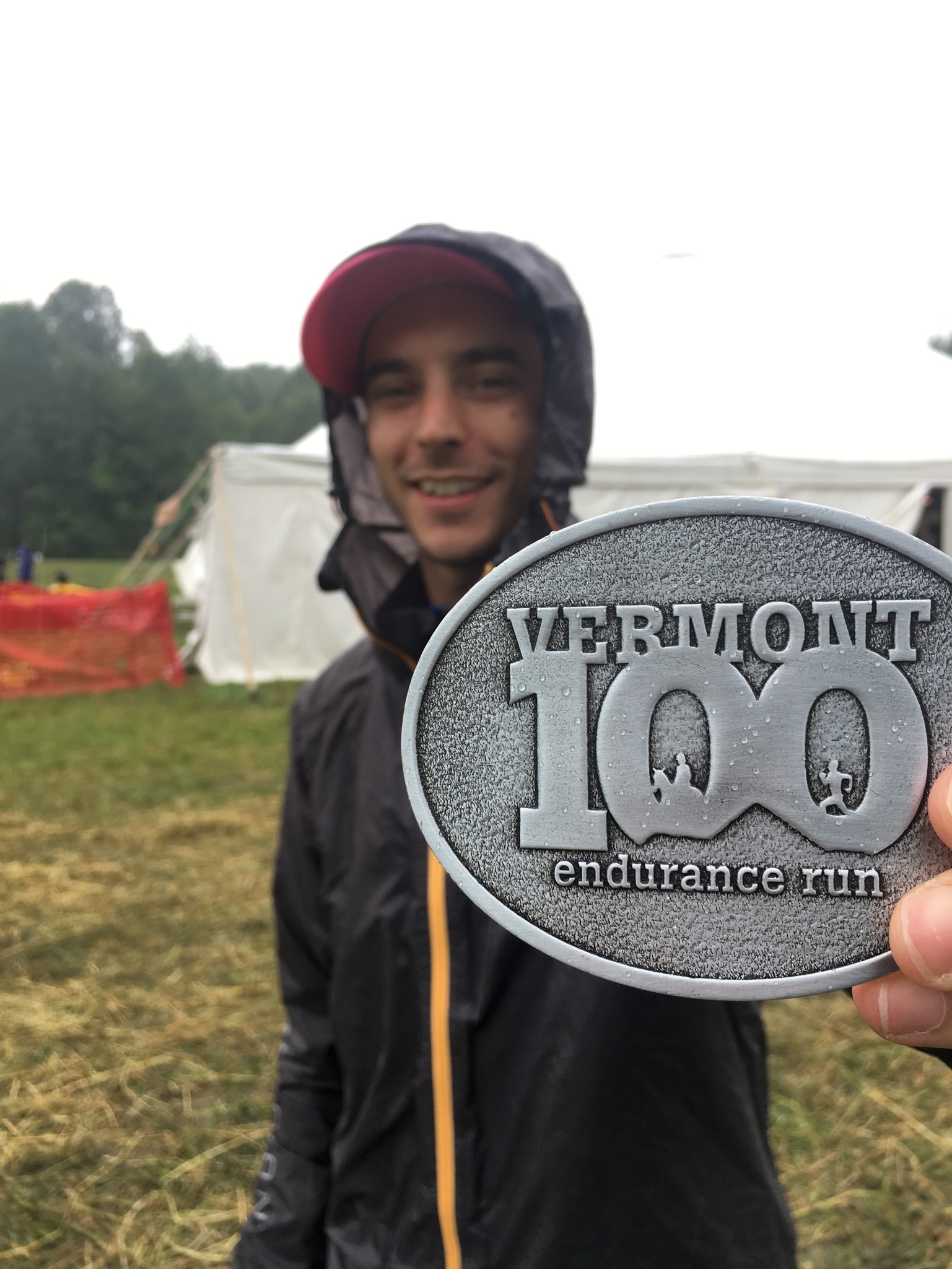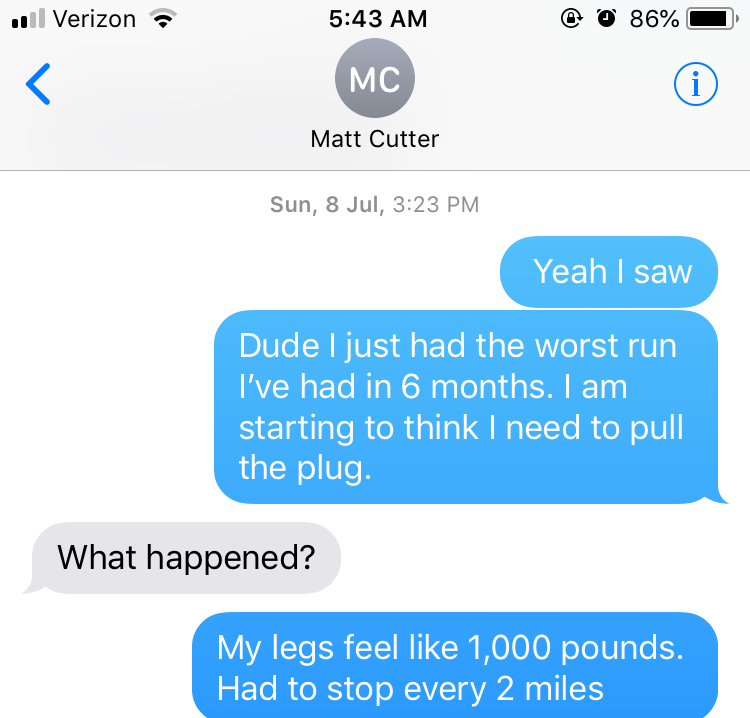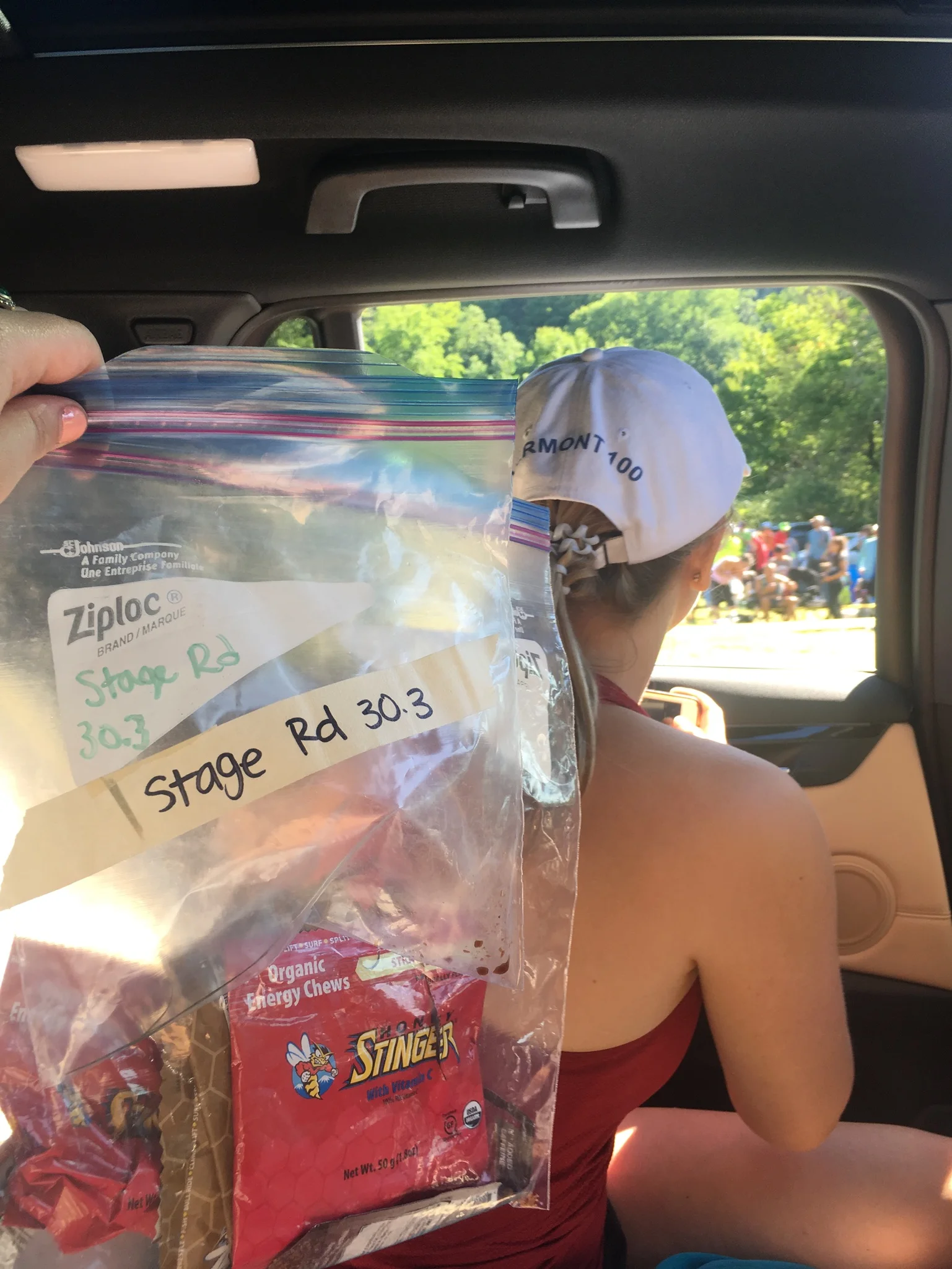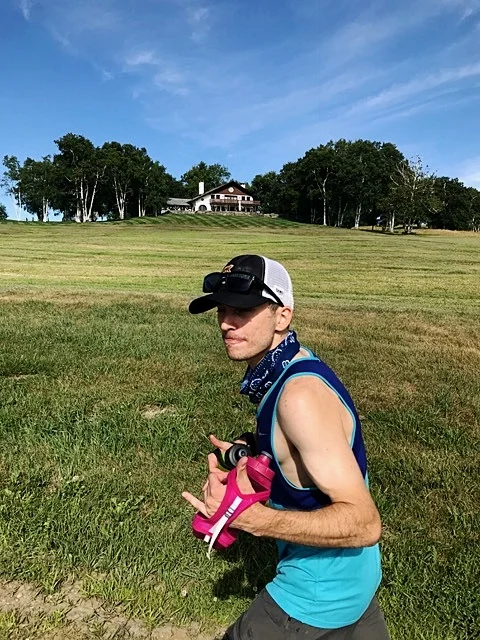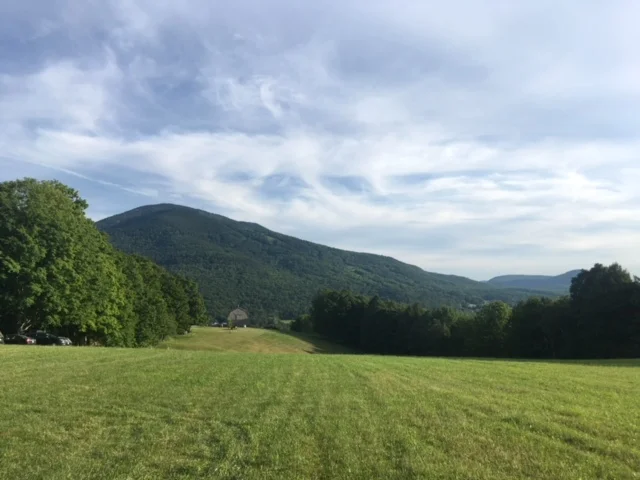Vermont 100 Race Report (July 2018)
In the past week, I have received many messages from people asking about my incredible "day" where I ran 100 miles.
To respond: Running 100 miles is not a single-day accomplishment. Instead, a 100 mile feat is the product of a lifetime of experience, melded into a singular, focused determination. It's 6+ months of physical discipline and a well-executed nutrition/hydration plan. It's a the culmination of everyday, showcased in one.
In this recap, I will break down the ups-and-downs of the race, while also peeling back the curtain to show how it all came to be.
Training
I officially “started” my physical training for VT 6 months ago, with snow-covered roads and sub-zero temps. I wanted 2018 to be the biggest year, which meant attempting my first 100-miler. Why not? I yearned for challenge and was ready to raise the bar. So, I started with the first step: run!
I ran 25 miles on my 25th birthday in January, then ran the Boston Marathon in-reverse in March. I ran the TARC Spring Classic 50K in April, and the Pineland Farms Trail 50 Miler in May. This was a gradual, solid build-up in mileage, which allowed me to slot in several key training blocks between these dates. With one final 4-week block in June, my legs felt primed to take on the hundred.
Admittedly, training in Boston for a race with 17,000 feet of ascent is not ideal, but hey, it’s just running! In the words of the great Scott Jurek, "sometimes you just do things!"
I got to know Summit Ave in Brookline very well, a short, .1/4 mile / 250 ft. neighborhood climb that became my morning Cup of Joe. Repeats, up and down. If you go there on Saturday there’s usually a kid selling lemonade in-front of the 4th house on the right. I never had cash on me, so I don’t think he likes me very much, but I always wanted some lemonade. Sorry, kid!
On the weekends, I fled to Wachusett Mountain in central MA to find more vert. The 3-mile auto road up Wachusett is perfect training ground for anyone preparing for VT, with similar grades of elevation to the course. A couple solo marathons at Wachusett (in the heat) got my body tuned-up for the climbing. Mountain repeats also created a logistically conducive environment to practice my nutrition plan and calorie intake (more on that later).
Injury Strikes
About 4 weeks before VT100 I was on a trail run and felt a pop in my left knee. I was coming off the biggest training week of my life, notching nearly 80 miles and 9,000 ft. of climbing. Over the next few days, my knee started to swell. Pain slowly splintered from my hips to groin — I was crushed. Though I continued to “train”, my easy runs became hard. Any speed or stride workouts I started were ultimately cut short or omitted due to fragile legs.
Mentally, this was tough to swallow. Hobbling around my apartment 2 weeks before the race, I was finding it hard to envision a 100 mile run.
“I can’t walk to the grocery store without pain, how will I run for an entire day?” I thought about pulling the plug, and sent this text to my brother on July 8th:
After a few days of swimming and treadmill hiking, I took three consecutive days off. No running, no nothing! I started dry needling and deep massage work at Active Recovery Boston. Big shout-out to Dr. Kelly for getting me ready for race-day.
With some additional rest, I was able to recover, although the injury created more uncertainty heading up to Vermont.
Looking back, I don't think I was over-trained at all. It appears my hips are quite weak, which was putting extra stress on my knees, groin and ankles. Human physiology is incredibly connected — usually the pain you feel is actually deriving from somewhere else.
I was pain-free by the time I toed the starting line, which was great! You can bet this offseason I'll be on a hip strengthening program.
Race Day
I arrived in Vermont on Friday afternoon, checked-in, got my bib, and went through Medical. VT100 requires each runner to weigh-in before the race. If you are having medical problems during the run, the Medical Team has the right to check your body weight to determine any dangerous weight-loss (approx. -5%). I did not run into any medical issues during the race, so therefore this did not come-up for me.
Pictured below are the amazing ~400 runners, countless volunteers and crew getting ready for race day.
Pre-race meeting
Aside from that, I have nothing noteworthy to share about the day-prior to the race, other than the fact that I got a total of 60 minutes of sleep. With a 2:20am alarm set, I was too jacked up to sleep!
I didn't even need my alarm because I was wide awake at 1:58am. I put a half-bagel in my mouth, had some muesli with yogurt, a banana, few sips of coffee, and was ready to rock. Oh, and copious amounts of anti-chafe Body Glide.
Course
The VT100 course is a beautiful. The majority of the course is run on dirt — amazing Vermont country backroads, which wind in-and-around the Woodstock area. I'm guessing about 10% of the course is run on actual trails in the woods. There's only a few (1-2) miles run on pavement.
A fun fact is that the VT100 is also a horse race! This is also why there is no music allowed, as it is essential to be able to communicate with riders and horses. It certainly adds another element to rudimentary nature of race. Super cool. The riders even ride with glow-sticks in the night so you can see them.
The course boasts 17,000 feet of climbing, although my GPS clocked 15,000 (see above). For those who have hiked Mt. Washington, the highest peak in the northeast, they are familiar with its 5,000 ft. of ascent. The VT100 course would be equivalent of summiting Mt. Washington 3 times all while covering 100 miles.
Credit: Northeast Race Photo | https://worldsmarathons.com/marathon/vermont-100-endurance-run
Crew! (left to right) Steve, Drew, Nancy, Shelby, Lucy, Matt
Crew
First off, it is optional to have a crew. Many runners opt to run the race "solo" or unsupported. This means they prepare "drop bags" with gear and food to access along the course.
I opted to have a crew for Vermont, which was my family, girlfriend Lucy, and good friend Drew.
I saw my crew a total of 8 times on the course. While I ran on the trail, my crew would drive on the road to meet me at the next aid station. They'd park, set-up my gear and food, and wait for me to arrive. Once I rolled into the aid station, my goal was to re-fuel as efficiently as possible. In-and-out in under 2 minutes was the goal, with no sitting unless I needed to change my socks (I never did). I accomplished the sub 2-minute goal at every aid station.
To prepare for this efficiency, I hosted a crew meeting at my apartment one week before the race. I highly recommend having this type of pre-race meeting to anyone running with a support crew. I labeled small ziplock bags with specific foods for each crew-accessible aid station. I walked them through my race and nutrition plan. My mother, Nancy, highlighted, sticky-noted, and arrowed throughout a Vermont Road Atlas for "back-up", even though detailed driving instructions are provided in the Runner's Handbook. You can never be too prepared! A week later, when we arrived in Vermont, we didn't have to worry about any logistics at all.
I chose to have a pacer as well, (also optional) which was my older brother, Matt. Pacers are typically allowed in 100 mile races at a specific mile mark. In Vermont, pacers are allowed after mile 70. In general, pacers are helpful for a couple reasons: Good company, they monitor your food/water intake, make sure you are urinating and make sure you stay on-course. And, of course, who doesn't love running in the woods with friends?
Hydration
Balancing sodium intake with water is always a delicate balance. There’s a very fine line between not enough water vs. too much water, and not enough salts.
I was carrying two 22oz bottles, which wrapped around my hands for easy access to water. The majority of runners were wearing camelback/ultra-packs on their backs, which in my opinion wasn't necessary. With water stops every 3-5 miles, a backpack only adds more weight. I trained for speed, so I wanted to run fast for as long as I could.
I was hoping to urinate every 3-4 hours, but due to the heat, I was sweating-out all the liquid I was putting-in. I upped my water intake around 50 miles, which then had me concerned about hyponatremia, but I was sweating so I figured I’d be okay.
My sister, Shelby, was also putting an E-Cap (condensed salt pill) in my mouth every time I saw her. I was also crushing pickles, vegetarian soup broth, and potatoes dunked in salt, which added to my sodium levels.
BASE Hydro was the electrolyte drink served at the aid stations, although I skipped drinking any. Electrolyte drink mixes like BASE and Gu Roctane are fantastic options for calorie intake during ultra events (a single serving can pack 250 calories & 2000mg amino acids. That’s a lot of mojo!). The problem for me is that these destroy my stomach. Instead, I plopped a Nuun tablet in one of my bottles every ~1 hour, which have 260mg of sodium per tab. They don’t provide any calories, (10 per serving) so I was aware that I’d have to keep cranking cals outside my bottles.
For water, I was putting down a bottle of H2O per hour (22oz). I was getting concerned that I wasn’t urinating, (I peed a little at mile 50) but I was sweating a ton so I was comforted that I was using the fluids that were going in. Looking back, it's concerning that I was drinking 22oz of water/hour and barely urinated at all. I definitely could have had more water, especially during the day when temperatures hit 86° F.
Food!
Famous ultrarunner Jim Walmslay once said that running 100 miles is as much an eating competition as it is running. He's spot-on! There is no room for error with nutrition; if you are low on calories and bonk, your day is done. If you're dehydrated and bonk, your day is done. If you are trying to play catch-up on calories later in the race, you're probably walking while your body focuses on digestion, instead of focusing on running.
For nutrition, I planned on consuming 200-250 calories per hour. My plan was to have this divided between Clif Gels, Clif Bars, Stinger Waffles and Honey Stinger gummies. Each of these pack about 110-160 calories, so I figured 1.5 “things” per hour would do the trick.
A typical ziplock bag I prepared for each aid station where I'd see my crew. These calories would tide me over until the next aid station.
I stuck to my plan for the first 40 miles of the race. I was slightly hungry early in the race, which is always a good sign, and also an indication you need more food. I'd rather be hungry than nauseous, and my body was using the calories I was putting in. At mile 50 or so, the chocolate Clif gels were going down so smooth, I told my crew that’s all I wanted. Actually, I demanded it. "Only the gels, only the gels!" I yelled at them (sorry guys!). I'm sure many fellow runners can relate when something is going down so smooth.
The chocolate gels were fueling my fire; I wanted more gels, I wanted them badly. For the remainder of the race, I had a chocolate gel every 30 minutes, sometimes every 25 when I felt the need. My stomach never had a problem.
Total food consumed:
~30 chocolate Clif gels
5 honey stinger packs
3 stinger waffles
4 handfuls of potatoes with salt
1 almond butter & jelly sandwich
2 cups of vegetarian soup broth
3 bananas
1 Vermont waffle with Maple Syrup
3 cups of coffee
32oz of Mountain Dew
16oz Gatorade
Lots of watermelon and pickles
Race
First 30:
July 21, 2018 - race day. The race kicked off at 4:00am and it was go-time. Even though it was pitch-dark, I barely needed my headlamp because of the amount of light provided by other runner's lights. We were bunched up the first few miles as people chatted and got acquainted with new running buddies.
A group of us discussed a race in Silverton, CO called the Hardrock 100 — one of the most iconic 100-mile races in the country. Hardrock was taking place the same weekend. By coincidence, the top Hardrock finishers in Colorado happened to be finishing around the same time as we started running in Vermont.
During the first marathon, I focused on keeping my breath steady. Listen to the body. Breathe. I checked my Garmin's wrist heart-rate monitor to spot-check my HR. I don’t normally trust the wrist HR, but it was good to reference to keep things calm. If my breath was laboring at all, or my heart-rate creeped up to 150, I slowed down. I was power hiking most of the hills to save energy and mellow my breathing. I was running a modest pace on the downhills to save my quads; I didn't want blown quads at mile 80. I knew I'd need them ready to crank-up the pace if I was feeling good.
I watched the sunrise, dropped my headlamp at mile 7, hammered calories, and ran alongside some new trail friends: a Professor, a Leadman, a running coach. I didn't catch any names. We all had our own reasons for running, but it didn't matter now. Miles ticked by.
This got me to Stage Road (mile 30) in 5:03 feeling GREAT. I remember a volunteer telling me at Stage Road that I was in 36th place; I said to myself “I probably feel better than most of the 35 people in front of me.” This was a confidence booster, and the legs kept rolling…I said to myself…alright, let’s jam!
Cooling down before things started to get real.
30-70
Aid-station to aid-station. "Aid to Aid". That was the flow. As the sun started to rise and the temp got higher, I made a conscious effort to continue my electrolyte and hydration plan. My Nuun tablets were going down easy and I was feeling comfortable with pacing. As I neared mile 48, my first stop at Camp 10 Bear, I was excited.
10 Bear is a party in a pasture (thank you, TARC volunteers!) and I was stoked to see my crew. I was in-and-out of 10 Bear in under 1 minute. After leaving 10 Bear, I settled into a steady pace and got ready for some serious climbing. There were other runners around me, but nobody spoke. The communal focus was palpable.
Due to terrain, the next 10 miles (48-58) were the most difficult of the race, in my opinion. The heat was getting to me, and my legs were officially tired as hell. I don’t think it’s possible to run 50 miles without your legs getting fatigued; at this point, it merely becomes a question on how long you can keep going and ignore the pain.
There are two major climbs between 48-58. When I got to the second at mile 55, I started swearing under my breath. I settled into a firm power-hike up to Margaritaville (58). Hands-on-knees type of power hike. Once I got there, I was cooked. I looked at my crew and wondered how I’d make it 42 more miles. “This is hard. Really. Damn. Hard.” I remember quietly squeaking as I sipped Mountain Dew.
I still managed to make it out of Margaritaville in under two minutes, but I wasn't feeling good. I had 12 miles to loop back to Camp 10 Bear (mile 70) where I’d be picking up my brother Matt, who’d pace me to the finish. Morale was low. All I could think was "42 more", which seemed inconceivable.
Swearing under my breath became pretty routine through the next 12 miles. I tried to keep things positive and optimistic. So, I made a rule: Every time I said “fuck this” to myself, I tried to come up with an overpowering positive thought to push any pessimism out of my head. I thought about my crew who was here in this heat, waiting to see me just for a minute to stick ice in my bandana. How lucky am I? I continued to come up with a list of what I was grateful for, and why I was privileged to be running. Every time I saw my crew I made sure to thank them for their time. A grateful runner = a happy crew!
On the course, all I had to worry about was putting one foot in front of the other – many people in this world have to worry about far greater abuse, violence, poverty. The list goes on.
As my mind dug deeper into a hole, I sang the song “Busted Stuff” by Dave Matthews in my head. I was busted and broken, but the jam wasn’t over. In fact, I was still in the middle of the song and hadn’t gotten to the final chorus…
Jamming along, somewhere around mile 70.
70-100
It's just running. This was the mantra my coach had given on me. And he was right — all I had to do was run. Wasn't I born to do this? Born to run?
The miles heading back into 10 Bear are downhill, so I was running and letting gravity do the work. Finally, I arrived at 10 Bear. The burden of making it to 70 was over. The race started now, 30 miles from the finish line. Looking back, this was the furthest I had ever run in my life, and I still had 30 to go, but it didn't matter. Picking-up my brother really helped changed my mindset and turn a new page in the race! We fist bumped and took off running — just like we do at 5:45am, three days a week, without fail.
The next 5 miles went by quickly as we were catching-up on the day. The sun was finally starting to set and we were running on shaded trail.
All smiles somewhere around 75!
“It’s just running.”
My goal was to get to 70 miles and then start "opening it up" if I felt good, which I did.
I almost had to check myself: "Do I actually feel pretty good right now?!" My legs hurt, but I was still able to run a solid pace.
I continued to have a chocolate gel every 30 minutes. Since we ran a lot of vert, I remember feeling I needed more calories, so I went to every 25 minutes.
I started taking longer strides on downhills, and running the uphills. When my brother asked me how my legs were doing, I responded with two words: "positive, positive." I was doing everything in my power to maintain confidence.
Aside from my legs, my lower back was starting to give-out. I assume it was due to the amount of climbing I was doing, which altered my stride. I remember running with my hand on my lower back to keep myself up-right. I kept moving. My feet were unscathed with no blisters, which I was thankful for!
As I arrived to the "Spirit of '76" I was ready for my "evening-wear." I grabbed my Petzl Reaktik headlamp. Matt put on a headlamp & an additional waistlamp for extra lighting. My crew was outstanding and ready to get me in-and-out in under two minutes. I remember one volunteer calling my crew the best NASCAR crew in the whole race — it was fun to watch.
I took off my shirt and my friend Drew sponged me down and toweled me dry (what great friends do). My mother, Nancy, put a fresh shirt over me, as my girlfriend Lucy shoved as many chocolate gels she could fit in my pockets. Meanwhile, my father, Steve, filled my bottles with water and my sister handed me an orange gatorade, which I proceeded to chug. With a Rob Gronkowski slam of my empty bottle, I took-off back into the woods. I believe I passed 5 or 6 runners at that aid station.
My speedy crew getting me in-and-out of aid stations all day
Bill's, mile 88
Running nonstop from sunrise to sunset is magical. There’s a piece of the circadian rhythm that emerges when running for such an extended time. It’s unattainable day-to-day, but when running, the feeling hatches; the day is condensed into moments – back to back snapshots of running, step by step, strung together to create a harmony on the trail. The whole day is a blur, but individual moments remain vivid. It’s a cyclical beauty.
I felt relief at sunset. Throughout the day I was concerned about "the heat, the heat, the heat." With the temperature dropping, I could spend less mental energy focused on hydration, and more energy spent on running.
Around mile 84 I distinctly remember having low-energy, and it didn't feel like a lack of calories or a hydration problem. I felt tired. The problem became apparent when I was trying to tell my brother a story and I stopped after a few words. I didn't have energy to talk anymore. Caffeine was the need I craved.
I proceeded to have two caffeinated energy gels. I also drank a cup of coffee at all three of the next aid stations. Sure, my legs were still feeling weak, but my mind was awake again!
The next aid was Bill's at mile 88. This was another quick one. My mouth was full of sugar and felt disgusting so I brushed my teeth. After quickly applying some vaseline, I kept pushing. I was running everything that was runnable.
Running time & male race standings
It was officially the "golden hour" and the sun was setting. I turned my headlamp on. Miles 88-90 trudge through densely wooded trails. The hundreds of glow-in-the-dark markings on trees looked like green lanterns, floating in complete darkness.
After a hard-right turn, we emerged from the woods, running downhill through an open grass field. Looking out on the vast pasture, there's nothing man-made the eye can see aside from bopping headlamps and fireflies in the distance. It's a picturesque Vermont beginning to the final chapter.
Mile 95: Polly's. A half-mile from the aid station, a volunteer ran towards me to take my order:
"One waffle?"
"Sure, I'll take it!" I yelled back.
I shoved a tasty Vermont waffle with maple syrup in my mouth, took down another cup of coffee, and that's pretty much all I remember. I ditched a handheld bottle and I was 5 out. Is this going to happen?
“Make friends with pain, and you will never be alone. ”
The last 5.4 miles I am proud to say I motored! According to live tracking, I clocked the 6th fastest split between Polly's (94.6) and the finish line. Jens Voigt, one of my favorite professional cyclists, is famous for saying "shut up, legs!" This was the mantra for the last 5. It hurt to walk, it hurt to run — so I ran.
Finish
This report would not be be finished without an authentic description of what happened when I finished. The truth is, I really don't remember.
I recall someone asking me to turn my headlamp off because I was blinding everyone in front of me. I didn't actually register what was happening. I mumbled softly, "what is going on?" Someone responded, "you just ran 100 miles, congratulations."
As I limped forward a few feet from the finish line, I sat down on a pile of dirt. I bent my neck down towards my knees and covered my face with sweaty hands. Raw emotion came over me as I had trouble holding back tears. It was raw, uncontrollable emotion. It was a release of an entire day in one second, a release of the training, work, and discipline I'd put into achieving this goal. Staying focused for such a long period of time without reprieve is a colossal effort on the mind. Then, in a moment—it's over.
I felt a large outpour, both physically and mentally, as I sat on on a that pile of dirt, the first time off my feet in 19 hours.
What a day.
Stats
Time - 18:53:04
Overall - 18
Men - 13
Fun had - Lots (that's why we do it!)
Thank You
First thank-you goes to the volunteers, Vermont Adaptive and the staff at the VT100. You all put on a fantastic, inclusive race with great energy.
I wouldn't have had such a fun day without the help from my coach Scott Traer at RunFastah. Scott’s training program put me through the ringer and prepared me incredibly well. His knowledge got me to race-day with confidence, instead of looming questions like, “did I train enough?”
If you are looking to accomplish a running goal, I highly recommend Scott and Samantha’s operation at RunFastah. They know what they're doing.
As any ultrarunner knows, balancing high-mileage with work, family, and significant others can be demanding. At FareHarbor, I am lucky to have incredibly badass colleagues who've supported all my endeavors. Our motto is DWIFT, (Do Whatever it Fucking Takes) which was embodied during my training and race-day. When I walk into the office every day, I am constantly reminded that my hard work didn't stop when I took my running shoes off in the morning. It's just beginning. We're routinely taking things to the next level, pushing harder than ever before. Our "Ohana" (family) encourages each-other to be our very best, taking ownership over our work and personal goals. We're always ripping.
Lastly, I want to thank my family, Lucy, and Drew. I am biased, but I had the best crew on that course. 100 miles comes with sacrifice and you all understood the depth of my goal. Thank you.
Gear:
Petzl Reaktik headlamp (300 lumens)
GoMotion Orion lightbelt (150 lumens)
Injinji toesocks
Topo Ultrafly shoes (amazing shoes!)
Nathan SpeedMax Plus 22oz Bottles (x2)
Buff neckwear for ice
Garmin Fenix 5
Anti-chafe Body Glide
Oakley sunglasses
Nike singlet
Patagonia shorts
Tired legs
“Running 100 miles is not a single-day accomplishment. Instead, a 100 mile feat is the product of a lifetime of experience, melded into a singular, focused determination. It’s 6+ months of physical discipline and a well-executed nutrition/hydration plan. It’s a the culmination of everyday, showcased in one.”
